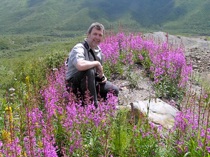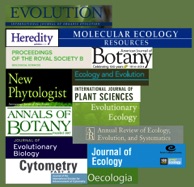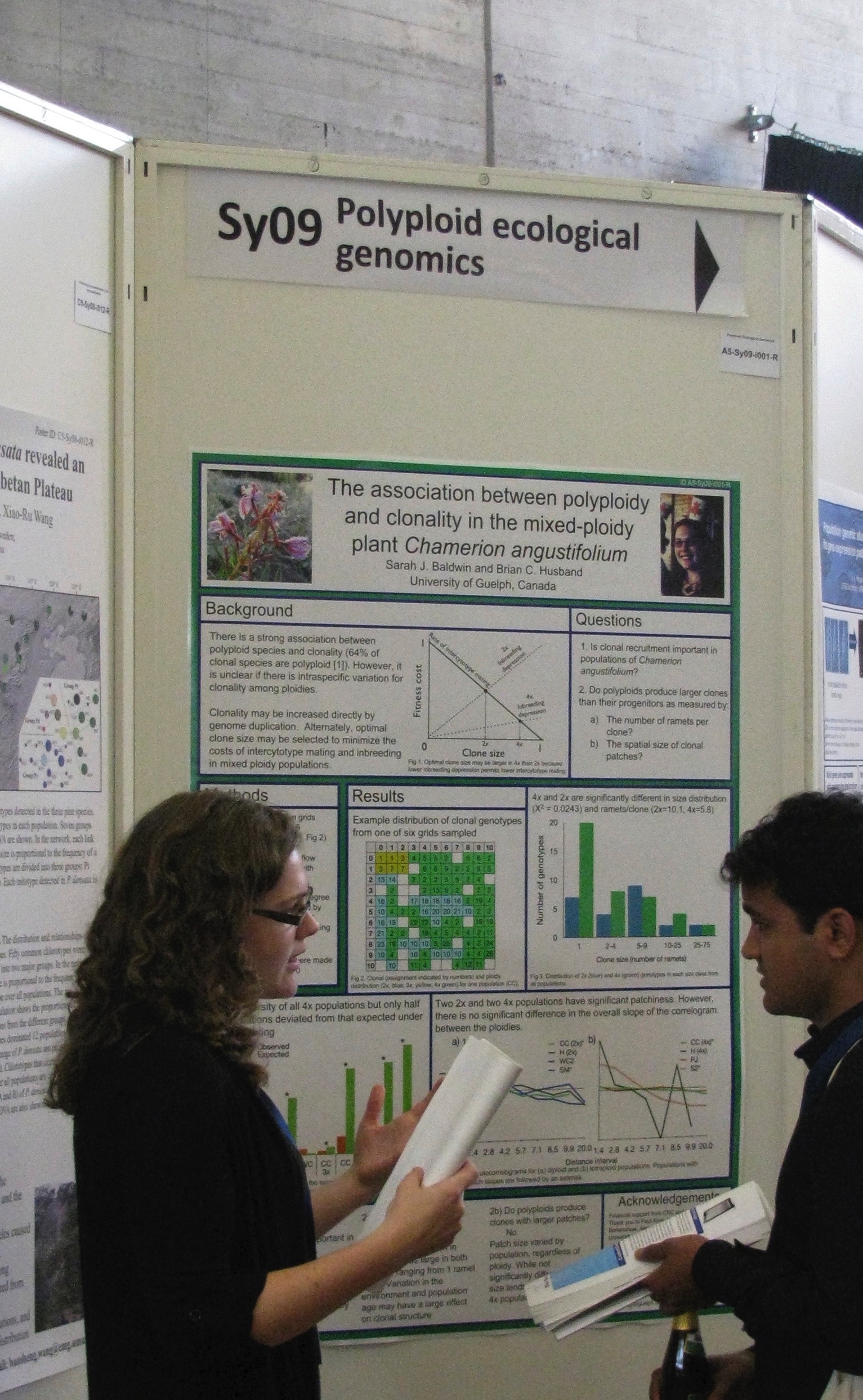



Function and Evolution of Plant Reproductive Systems
Miller, J.S., A. Kamath, B.C. Husband and R.A. Levin. 2016. Correlated polymorphism in cytotype and sexual system within a monophyletic species, Lycium californicum. Annals of Botany 117:307-317. doi:10.1093/aob/mcb 167/
Martin, S.L., C.A. Sauder, T. James, K.W. Cheung, F.M. Razeq, P. Kron and L. Hall. 2015. Sexual hybridization between Capsella bursa-pastoris (L.) Medik (♀) and Camelina sativa (L.) Crantz (♂) (Brassicaceae). Plant Breeding 134:212–220.doiI:10.1111/pbr.12245
Jones, N.T., B.C. Husband and A.S. MacDougall. 2013. Reproductive system of a mixed-mating plant responds to climate perturbation by increased selfing. Proceedings of the Royal Society B: Biological Sciences 280:20131336.
Ashman, T.-L., A. Kwok and B.C. Husband. 2013. Revisiting the dioecy-polyploidy association: alternate pathways and research opportunities. Cytogenetic and Genome Research 140:241-255 doi:10.1159/000353306
Baldwin, S.J. and B.C. Husband 2013. The association between polyploidy and clonal reproduction in diploid and tetraploid Chamerion angustifolium. Molecular Ecology 22:1806-1819. doi:10.1111/mec.12217
Ozimec, B. and B.C. Husband. 2011. Effect of recurrent selfing on inbreeding depression and mating system evolution in an autotetraploid plant. Evolution 65:2038-2049. doi:10.1111/j.1558-5646.2011.01259.x
Kron, P. and B.C. Husband. Botany. 2009. Hybridization and the reproductive pathways mediating gene flow between native Malus coronaria and domestic apple Malus domestica. Botany 87:864-874.
Burgess, K.S., M. Morgan and B.C. Husband. 2008. Interspecific seed discounting and the fertility cost of hybridization in an endangered species. New Phytologist 177:276-284.
Husband, B.C., B. Ozimec, S.L. Martin and L. Pollock. 2008 Mating consequences of genome duplication: current patterns and insights from neopolyploids. International Journal of Plant Science 169:195-206.
Ramsey, J., A. Robertson and B.C. Husband 2008. Rapid adaptive divergence in new world Achillea, an autopolyploid complex of ecological races. Evolution 62:659-663.
Stehlik, I., P. Kron, S.C.H. Barrett and B.C. Husband 2007. Sexing pollen reveals female bias in a dioecious plant. New Phytologist 175:185-194.
Clark, M.J. and B.C. Husband. 2007. Plasticity and flower closure in response to pollination in Chamerion angustifolium (Onagraceae). International Journal of Plant Science 168:619-625.
Kron, P. and B.C. Husband. 2006. The effects of pollen diversity on plant reproduction: insights from apple. Plant Sexual Reproduction 19:125-131.
Burgess, K.S. and B.C. Husband. 2006. Habitat differentiation and the ecological cost of hybridization. Journal of Ecology 94:1061-1069.
Routley, M.B. and B.C. Husband. 2006. Sexual interference within flowers of Chamerion angustifolium (Onagraceae). Evolutionary Ecology 20:331-334.
Yeung, K., A. Savage, B.C. Husband, B. Igic, J. Miller and J.R. Kohn. 2005. Ploidy and gender in Lycium Californicum (Solanaceae). Evolution 59:2048-2055.
Burgess, K.S., M. Morgan, L. DeVerno and B.C. Husband 2005. Asymmetrical introgression between two Morus species (M. alba, M. rubra) that differ in abundance. Molecular Ecology 14:3471-3483.
Routley, M.B. and B.C. Husband. 2005. Responses to selection on male-phase duration in Chamerion angustifolium (Onagraceae). Journal of Evolutionary Biology 18:1050-1059.
Wolfe, B., B.C. Husband and J.N. Klironomos. 2005. Effects of a belowground mutualism on an aboveground mutualism. Ecology Letters 8:218-223.
Dafni, A., P. Kevan and B.C. Husband (Editors). 2005. Practical Pollination Biology. Enviroquest, Cambridge, Ontario.
Routley, M.B., R.I. Bertin and B.C. Husband. 2004. Correlated evolution of dichogamy and self-incompatibility: a phylogenetic perspective. International Journal of Plant Science 165:983-993.
Sage, T.L, B.C. Husband and M.R. Routley. 2004. Plant Breeding Systems. In, (A. Dafni, P.G. Kevan and B.C. Husband, eds.) Field Methods in Pollination Ecology, Enviroquest, Cambridge, Ontario.
Burgess, K.S. and B.C. Husband. 2004. Maternal and paternal contributions to the fitness of hybrids between red and white mulberry (Morus, Moraceae). American Journal of Botany 91:1802-1808.
Routley, M.R., P. Kron and B.C. Husband. 2004. The consequences of clone size for paternal and maternal success in domestic apple (Malus x domestica). American Journal of Botany 91:1326-1332.
Routley, M. and B.C. Husband. 2003. The effect of protandry on siring success in Chamerion angustifolium (Onagraceae) with different inflorescence sizes. Evolution 57:240-248.
Burgess, K.S. and B.C. Husband. 2002. The impact of hybridization on the endangered red mulberry (Morus rubra) in Canada. Proceedings of the Parks Research Forum of Ontario.
Husband, B.C. and K. Burgess. 2001. Evaluating hybridization as a cause of species endangerment: a role for systematics in conservation. In, (J.B Phipps and P.M. Catling, eds.), Bioconservation and Systematics. Proceedings of the Canadian Botanical Association Conference Symposium in London, Ontario, June 2000.
Kron, P., B.C. Husband, P. Kevan and S. Belaousoff. 2001. Factors affecting pollen dispersal in high-density apple orchards. Hortscience 36(6):1039-1046.
Kron, P., B.C. Husband and P. Kevan. 2001. Across- and along-row pollen dispersal in apple orchards: evidence from allozymes. Journal of Horticultural Science and Biotechnology 76:286-294.
Lemon, G.D., U. Posluszny and B.C. Husband. 2001. Potential and realized rates of vegetative reproduction in Spirodela polyrhiza, Lemna minor, and Wolffia borealis. Aquatic Botany 70:79-87.
Dorken, M. and B.C. Husband. 1999. Self-sterility in the understory herb, Clintonia borealis (Liliaceae). International Journal of Plant Science 160:577-584.
Husband, B.C. and J.E. Gurney. 1998. Offspring fitness and parental effects as a function of inbreeding in Epilobium angustifolium (Onagraceae). Heredity 80:173-179.
Husband, B.C. and D.W. Schemske. 1997. Effects of inbreeding depression in diploid and tetraploid populations of Epilobium angustifolium: implications for the genetic basis of inbreeding depression. Evolution 51:737-746.
Husband, B.C. and D.W. Schemske. 1996. Evolution of the magnitude and timing of inbreeding depression in plants. Evolution 50:54-70.
Husband, B.C. and S.C.H. Barrett. 1995. Estimates of gene flow in Eichhornia paniculata (Pontederiaceae): effects of range substructure. Heredity 75:549-560.
Husband, B.C. and S.C.H. Barrett. 1995. Estimating effective population size: a reply to Nunney. Evolution 49:392-394.
Husband, B.C. and D.W. Schemske. 1995. Magnitude and timing of inbreeding depression in a diploid population of Epilobium angustifolium (Onagraceae). Heredity 75:206-215.
Barrett, S.C.H., B.C. Husband and W.W. Cole. 1993. Variation in outcrossing rates in Eichhornia paniculata: temporal changes in populations of contrasting style morph structure. Plant Species Biology 8:141-148.
Husband, B.C. and S.C.H. Barrett. 1993. Multiple origins of self-fertilization in tristylous Eichhornia paniculata: inferences from style and allozyme variation. Journal of Evolutionary Biology 6:591-608.
Husband, B.C. and S.C.H. Barrett. 1992. Genetic drift and the maintenance of the style-length polymorphism in tristylous Eichhornia paniculata. Heredity 69:440-449.
Husband, B.C. and S.C.H. Barrett. 1992. Effective population size and genetic drift in tristylous Eichhornia paniculata. (Pontederiaceae). Evolution 46:1875-1890.
Husband, B.C. and S.C.H. Barrett. 1992. Pollinator visitation in tristylous Eichhornia paniculata in northeastern Brazil. Oecologia 89:365-371.
Barrett, S.C.H. and B.C. Husband. 1990. Variation in outcrossing rates in Eichhornia paniculata: the role of demographic and reproductive factors. Plant Species Biology 5:41-55.
Barrett, S.C.H., M.T. Morgan and B.C. Husband. 1989. The dissolution of a complex genetic polymorphism: the evolution of self-fertilization in tristylous Eichhornia paniculata (Pontederiaceae). Evolution 43:1398-1416.
Biology of Small Populations, Species at Risk and Conservation Biology
McCracken, A., J.D. Bainard, M.C. Miller and B.C. Husband. 2013. Pathways of introduction of the invasive aquatic plant Cabomba caroliniana. Ecology and Evolution 3:1427-1439 doi:10.1002/ece3.530
Leifso A., A.S. MacDougall, B.C. Husband, J.L. Hierro, M. Kochy, M. Partel and D. Peltzer. 2012. Expansion of a globally pervasive grass occurs without substantial trait differences between home and away populations. Oecologia 170:1123-1132.
Kron, P. and B.C. Husband. Botany. 2009. Hybridization and the reproductive pathways mediating gene flow between native Malus coronaria and domestic apple Malus domestica. Botany 87:864-874.
Burgess, K.S., M. Morgan and B.C. Husband. 2008. Interspecific seed discounting and the fertility cost of hybridization in an endangered species. New Phytologist 177:276-284.
Campbell, L.G. and B.C. Husband. 2007. Reproductive consequences of population size in self-incompatible plant, Hymenoxys herbacea (Asteraceae). New Phytologist 174:915-925.
Husband, B.C. 2006. Review of “Plant Conservation: A Natural History Approach. Bioscience 56:775-777.
Burgess, K.S. and B.C. Husband. 2006. Habitat differentiation and the ecological cost of hybridization. Journal of Ecology 94:1061-1069.
Burgess, K.S., M. Morgan, L. DeVerno and B.C. Husband 2005. Asymmetrical introgression between two Morus species (M. alba, M. rubra) that differ in abundance. Molecular Ecology 14:3471-3483.
Campbell, L.G. and B.C. Husband. 2005. Effective size and genetic drift in the clonal, self-incompatible plant Hymenoxys herbacea. Heredity 94:526-532.
Husband, B.C. and L.G. Campbell. 2004. Demographic and genetic responses to new environments: implications for ex situ conservation. In, (E. Guerrant, K. Havens and M. Maunder, eds.) Ex Situ Plant Conservation, Island Press, Washington.
Tindall , J.R., J.A. Gerrath, M. Melzer, K. McKendry, B.C. Husband and G. Boland. 2004. Ecological status of American chestnut (Castanea dentata) in its native range in Canada. Canadian Journal of Forest Research 34:2554-2563.
Burgess, K.S. and B.C. Husband. 2004. Maternal and paternal contributions to the fitness of hybrids between red and white mulberry (Morus, Moraceae). American Journal of Botany 91:1802-1808.
Burgess, K.S. and B.C. Husband. 2002. The impact of hybridization on the endangered red mulberry (Morus rubra) in Canada. Proceedings of the Parks Research Forum of Ontario.
Husband, B.C. 2002. Review of “Quantitative Methods for Conservation Biology”. The Quarterly Review of Biology 77:94.
Husband, B.C. and K. Burgess. 2001. Evaluating hybridization as a cause of species endangerment: a role for systematics in conservation. In, (J.B Phipps and P.M. Catling, eds.), Bioconservation and Systematics. Proceedings of the Canadian Botanical Association Conference Symposium in London, Ontario, June 2000.
Treberg, M.A. and B.C. Husband. 1999. Relationship between the abundance of Lythrum salicaria (purple loosestrife) and plant species richness along the Bar River, Canada. Wetlands 19:118-125.
Husband, B.C. and S.C.H. Barrett. 1998. Spatial and temporal variation in population size in Eichhornia paniculata in ephemeral habitats: implications for metapopulation dynamics. Journal of Ecology 86:1021-1031.
Barrett, S.C.H. and B.C. Husband. 1997. Ecology and genetics of ephemeral plant populations: Eichhornia paniculata (Pontederiaceae) in northeast Brazil. Journal of Heredity 88:277-284.
Husband, B.C. and S.C.H. Barrett. 1996. A metapopulation perspective in plant population biology. Journal of Ecology 84:461-469.
Husband, B.C. and S.C.H. Barrett. 1995. Estimating effective population size: a reply to Nunney. Evolution 49:392-394.
Schemske, D.W., B.C. Husband, M.H. Ruckelshaus, C. Goodwillie, I.M. Parker and J.G. Bishop. 1994. Evaluating approaches to the conservation of rare and endangered plants. Ecology 75:584-606.
Husband, B.C. and S.C.H. Barrett. 1992. Genetic drift and the maintenance of the style-length polymorphism in tristylous Eichhornia paniculata. Heredity 69:440-449.
Husband, B.C. and S.C.H. Barrett. 1992. Effective population size and genetic drift in tristylous Eichhornia paniculata. (Pontederiaceae). Evolution 46:1875-1890.
Husband, B.C. and S.C.H. Barrett. 1991. Colonization history and population genetic structure of Eichhornia paniculata (Pontederiaceae) in Jamaica. Heredity 66:287-296.
Barrett, S.C.H. and B.C. Husband. 1990. The genetics of plant migration and colonization. In, (A.H.D. Brown, M.T. Clegg, A.L. Kahler and B.S. Weir, eds.), Plant Population Genetics, Breeding and Genetic Resources, pp.254-277. Sinauer Associates, Mass.
Pollination and Reproductive Biology of Agricultural Plants
Kron, P. and B.C. Husband. Botany. 2009. Hybridization and the reproductive pathways mediating gene flow between native Malus coronaria and domestic apple Malus domestica. Botany 87:864-874.
Kron, P. and B.C. Husband. 2006. The effects of pollen diversity on plant reproduction: insights from apple. Plant Sexual Reproduction 19:125-131.
Kron, P., B.C. Husband, P. Kevan and S. Belaousoff. 2001. Factors affecting pollen dispersal in high-density apple orchards. Hortscience 36(6):1039-1046.
Kron, P., B.C. Husband and P. Kevan. 2001. Across- and along-row pollen dispersal in apple orchards: evidence from allozymes. Journal of Horticultural Science and Biotechnology 76:286-294.
Plant Barcoding and Flow Cytometry
Kron, P. 2015. Endopolyploidy, genome size, and flow cytometry. Cytometry Part A 87A:887-889. doi:10.1002/cyto.a.22718.
Kron, P. and B.C. Husband. 2015. Distinguishing 2N gamete nuclei from doublets in pollen using flow cytometry and pulse analysis. Cytometry Part A 87A:943-957. doi:10.1002/cyto.a.22696.
Percy D.M., G.W. Argus, Q.C. Cronk, A.J. Fazekas, P.R. Kesanakurti, K.S. Burgess, B.C. Husband, S.G. Newmaster, S.C.H. Barrett and S.W. Graham. 2014. Understanding the spectacular failure of DNA barcoding in willows (Salix): Does this result from a trans-specific selective sweep? Molecular Ecology 23:4737-4756.
Kron P., A. Kwok and B.C. Husband. 2014. Flow cytometric analysis of pollen collected from individual bees provides information about pollen load composition and foraging behaviour. Annals of Botany doi:10.1093/aob/mct257.
Kron, P. and B.C. Husband. 2012. Using flow cytometry to estimate pollen DNA content: improved methodology and applications. Annals of Botany 110:1067-1078. doi:10.1093/aob/mcs167.
Bainard J.D., B.C. Husband, S.J. Baldwin, A.J. Fazekas, T.R. Gregory, S.G. Newmaster and P. Kron. 2011. The effects of rapid desiccation on estimates of plant genome size. Chromosome Research 19:825-842.
Burgess, K.S., A.J. Fazekas, P.R. Kesanakurti, S.W. Graham, B.C. Husband, S.G. Newmaster, D.M. Percy, M. Hajibabaei and S.C.H. Barrett. 2011. Discriminating plant species in a local temperate flora using the rbcl + matK DNA barcode. Methods in Ecology and Evolution 2:333-340.doi:10.1111/j.2041-210X.2011.00092.x
Kesanakurti, P.R., A.J. Fazekas, K.S. Burgess, D.M. Percy, S.G. Newmaster, S.W. Graham, S.C.H. Barrett, M. Hajibabaei and B.C. Husband. 2011. Spatial patterns of plant diversity below-ground as revealed by DNA barcoding. Molecular Ecology 20:1289-1302.
CBOL Plant Working Group. 2009. A DNA Barcode for Land Plants. Proceedings of the National Academy of Sciences 106:12794-12797.
Fazekas, A.J., P.R. Kesanakurti, K.S. Burgess, D.M. Percy, S.W. Graham, S.C.H. Barrett, S.G. Newmaster, M.Hajibabaei and B.C. Husband. 2009. Are plant species inherently harder to discriminate than animal species using DNA barcoding markers? Molecular Ecology Resources 9:130-139.
Fazekas, A.J., K.S. Burgess, P.R. Kesanakurti, S.W. Graham, B.C. Husband, S.G. Newmaster, D.M. Percy, M. Hajibabaei and S.C.H. Barrett. 2008. Multiple multilocus DNA barcode combinations from the plastid genome discriminate plant species equally well. PLOS One 3: e2802.
Kron, P., J. Suda and B.C. Husband. 2007. Applications of flow cytometry to evolutionary and population biology. Annual Review of Ecology, Evolution and Systematics 38:847-876.
Suda, J., P. Kron, B.C. Husband and P. Trávníček. 2007. Flow Cytometry and Ploidy: Applications in Plant Systematics, Ecology and Evolutionary Biology. In, (J. Dolezel, J. Greilhuber and J. Suda, eds.) Flow Cytometry with Plant Cells. pp.103-130. Wiley-VCH Verlag GmbH & Co.
Biology of Aquatic Organisms
McCracken, A., J.D. Bainard, M.C. Miller and B.C. Husband. 2013. Pathways of introduction of the invasive aquatic plant Cabomba caroliniana. Ecology and Evolution 3:1427-1439 sdoi:10.1002/ece3.530.
Barrett, S.C.H., C.G. Eckert and B.C. Husband. 1992. Evolutionary processes in aquatic plant populations. Aquatic Botany 44:105-145.
Husband, B.C. and M. Hickman. 1989. The frequency and local abundance of Ruppia occidentalis in relation to sediment texture and lake salinity. Canadian Journal of Botany 67:2444-2449.
Husband, B.C. and M. Hickman. 1985. Growth and biomass allocation of Ruppia occidentalis in three lakes, differing in salinity. Canadian Journal of Botany 63:2004-2014.
Education
Husband, B.C., W.J. Bettger, C.L. Murrant, K. Kirby, P.A. Wright, S.G. Newmaster, J.F. Dawson, T.R. Gregory, R.T. Mullen, A. Nejedly, G. van der Merwe, K. Yankulov and P. Wolf. 2015. Applying a Linked-Course Model to Foster Inquiry and Integration in Large First Year Courses. Canadian Journal of Higher Education 45:244-260.
Miscellaneous Ecology and Evolutionary Biology
Wagg, C., B.C. Husband, D.S. Green, H.B. Massicotte and R.L. Peterson. 2011. Soil microbial communities from an elevational cline differ in their effect on conifer seedling growth. Plant and Soil 340:491-504. doi:10.1007/s11104-010-0621-x.
Gross, J., B.C. Husband and S. Stewart. 1998. Phenotypic selection in a natural population of Impatiens pallida (Balsaminaceae). Journal of Evolutionary Biology 11(5):589-609.
Ursic, M., R.L. Peterson and B.C. Husband. 1997. Relative abundance of mycorrhizal fungi and frequency of root rot on Pinus strobus L. seedlings in a southern Ontario nursery. Canadian Journal of Forest Research 27:54-62.
Causes and Consequences of Whole Genome Duplication (Polyploidy)
Husband, B.C. 2016. Effect of inbreeding on pollen tube growth and mutational load in diploid and tetraploid Chamerion angustifolium. American Journal of Botany [Special Issue]†103:1-9. doi:10.3732/ajb.1500243
Miller, J.S., A. Kamath, B.C. Husband and R.A. Levin. 2016. Correlated polymorphism in cytotype and sexual system within a monophyletic species, Lycium californicum. Annals of Botany 117:307-317. doi: 10.1093/aob/mcb167/
Martin, S.L., C.A. Sauder, T. James, K.W. Cheung, F.M. Razeq, P. Kron and L. Hall. 2015. Sexual hybridization between Capsella bursa-pastoris (L.) Medik (♀) and Camelina sativa (L.) Crantz (♂) (Brassicaceae). Plant Breeding 134:212–220. doi:10.1111/pbr.12245
McAllister, C., R. Blaine, P. Kron, B. Bennett, H. Garrett, J. Kidson, B. Matzenbacher, A. Glotzbach and A.J. Miller. 2015. Environmental correlates of cytotype distribution in Andropogon gerardii (Poaceae). American Journal of Botany 102:92-102. doi:10.3732/ajb.1400296
Smith, T.W., C. Walinga, S. Wang, P. Kron, J. Suda and J. Zalapa. 2015. Evaluating the relationship between diploid and tetraploid Vaccinium oxycoccos (Ericaceae) in eastern Canada. Botany 93:623-636. doi:10.1139/cjb-2014-0223
Kron, P. and B.C. Husband. 2015. Distinguishing 2N gamete nuclei from doublets in pollen using flow cytometry and pulse analysis. Cytometry Part A 87A:943-957. doi:10.1002/cyto.a.22696
Thompson, K.A., B.C. Husband and H. Maherali. 2015. No influence of water limitation on competition between diploid and tetraploid Chamerion angustifolium (Onagraceae). Journal of Ecology 103:733-741. doi:10.1111/1365-2745.12384
Thompson, K.A., B.C. Husband and H. Maherali. 2014. Climatic niche differences between diploid and tetraploid cytotypes of Chamerion angustifolium (Onagraceae). American Journal of Botany 101:1868-1875.
Ashman, T.-L., A. Kwok and B.C. Husband. 2013. Revisiting the dioecy-polyploidy association: alternate pathways and research opportunities. Cytogenetic and Genome Research 140:241-255. doi:10.1159/000353306
Sabara, H.A., P. Kron and B.C. Husband. 2013. Cytotype coexistence leads to triploid hybrid production in a diploid-tetraploid contact zone of Chamerion angustifolium. American Journal of Botany 100:1-9.
Martin, S.L. and B.C. Husband. 2013. Adaptation of diploid and tetraploid Chamerion angustifolium to elevation but not local environment. Evolution 67:1780-1791. doi:10.1111/EVO.12065
Baldwin, S.J. and B.C. Husband 2013. The association between polyploidy and clonal reproduction in diploid and tetraploid Chamerion angustifolium. Molecular Ecology 22:1806-1819. doi:10.1111/mec.12217
Martin, S.L. and B.C. Husband. 2012 Whole genome duplication affects evolvability in natural populations of a flowering plant. PLos One. 7(9): e44784. doi:10.1371/journal.pone.0044784
Husband, B.C., S.J. Baldwin and J. Suda. 2012. The incidence of polyploidy in plants: major patterns and evolutionary processes. In, (J. Greilhuber, J. Dolezel and J.F. Wendel, eds.) Plant Genomic Diversity Vol II, Springer.
Ozimec, B. and B.C. Husband. 2011. Effect of recurrent selfing on inbreeding depression and mating system evolution in an autotetraploid plant. Evolution 65:2038-2049. doi:10.1111/j.1558-5646.2011.01259.x
Baldwin, S.J. and B.C. Husband. 2010. Genome duplication and the evolution of conspecific pollen precedence. Proceedings of the Royal Society B: Biological Sciences 278:2011-2017. doi:10.1098/rspb.2010.2208
Maherali, H., A.F. Walden and B.C. Husband. 2009. Genome duplication and the evolution of physiological responses to water stress. New Phytologist, 184:721-731. doi:10.1111/j.1469-8137.2009.02997.x
Martin, S.L. and B.C. Husband. 2009. The influence of phylogeny and ploidy on range size in North American angiosperms. Journal of Ecology 97:913-922.
Husband, B.C., B. Ozimec, S.L. Martin and L. Pollock. 2008 Mating consequences of genome duplication: current patterns and insights from neopolyploids. International Journal of Plant Science 169:195-206.
Ramsey, J., A. Robertson and B.C. Husband 2008. Rapid adaptive divergence in new world Achillea, an autopolyploid complex of ecological races. Evolution 62:659-663.
Soltis, D.E, P.S. Soltis, D.W. Schemske, J.F. Hancock, J.N. Thompson, B.C. Husband and W.S. Judd. 2007. Autopolyploidy in the angiosperms; have we grossly underestimated the number of species? Taxon 56:13-30.
Kennedy, B., H. Sabara, D. Haydon and B.C. Husband. 2006. Pollinator-mediated assortative mating in mixed-ploidy populations of Chamerion angustifolium (Onagraceae). Oecologia 150:398-408.
Yeung, K., A. Savage, B.C. Husband, B. Igic, J. Miller and J.R. Kohn. 2005. Ploidy and gender in Lycium Californicum (Solanaceae). Evolution 59:2048-2055.
Husband, B.C. 2004. Review of “The Role of Chromosomal Change in Plant Evolution”. American Journal of Botany 91:621-625.
Husband, B.C. 2004. The role of triploids in the evolutionary dynamics of mixed-ploidy populations. Biological Journal of the Linnean Society 82:537-546.
Husband, B.C. 2004. What is know and not known about adaptation: a workshop synopsis. In Plant Adaptation: Molecular Genetics and Ecology. Proceedings of an International Workshop held December 11-13, 2002, in Vancouver, British Columbia, Canada. Edited by Cronk, Q.C.B., J. Whitton, R.H. Ree and I.E.P. Taylor. NRC Research Press, Ottawa, Ontario. pp.38-41.
Husband, B.C. 2004. Polyploidy and plant adaptation: a framework for future research. In Plant Adaptation: Molecular Genetics and Ecology. Proceedings of an International Workshop held December 11-13, 2002, in Vancouver, British Columbia, Canada. Edited by Cronk, Q.C.B., J. Whitton, R.H. Ree and I.E.P. Taylor. NRC Research Press, Ottawa, Ontario. pp.119-126.
Husband, B.C. and H.A. Sabara. 2003. Reproductive isolation between autotetraploids and their diploid progenitors in fireweed, Chamerion angustifolium. New Phytologist: online publication date December 18, 2003 (http://www.blackwell-synergy.com/links/toc/nph/161/1) Print citation: New Phytologist 161:703-713.
Johnson, M., B.C. Husband and T.L. Burton. 2003. Habitat differentiation in diploid and tetraploid Galax urceolata (Dispensiaceae). International Journal of Plant Science 164:703-710.
Husband, B.C., D.W. Schemske, C. Goodwillie and T.L. Burton. 2002. Pollen competition as a unilateral mechanism of reproductive isolation between diploid and tetraploid Chamerion angustifolium. Proceedings of the Royal Society of London 269:2565-2571.
Burton, T.L. and B.C. Husband. 2001. Fecundity and offspring ploidy in matings amond diploid, triploid and tetraploid Chamerion angustifolium (Onagraceae): consequences for tetraploid establishment. Heredity 87:573-582.
Burton, T.L. and B.C. Husband. 2000. Fitness differences amond diploids, tetraploids and their triploid hybrids in Chamerion angustifolium (Onagraceae): mechanisms of inviability and implications for polyploid evolution. Evolution 54:1182-1191.
Husband, B.C. 2000. Constraints on polyploidy evolution: a test of the minority cytotype exclusion principle. Proceedings of the Royal Society of London B 267:1-7.
Husband, B.C. and D.W. Schemske. 2000. Ecological mechanisms of reproductive isolation and coexistence of diploid and tetraploid Chamerion angustifolium. Journal of Ecology. 88:1-14.
Burton, T.L. and B.C. Husband. 1999. Population cytotype structure in the polyploid Galax urceolata (Diapensiaceae). Heredity 82:381-390.
Husband, B.C. and D.W. Schemske. 1998. Cytotype distribution at a diploid-tetraploid contact zone in Chamerion (Epilobium) angustifolium (Onagraceae). American Journal of Botany 85:1688-1694.
Husband, B.C. and D.W. Schemske. 1997. Effects of inbreeding depression in diploid and tetraploid populations of Epilobium angustifolium: implications for the genetic basis of inbreeding depression. Evolution 51:737-746.
Publications are organized according to the following topics:
• Causes and Consequences of Whole Genome Duplication (Polyploidy)
• Function and Evolution of Plant Reproductive Systems
• Biology of Small Populations, Species at Risk and Conservation Biology
• Pollination and Reproductive Biology of Agricultural Plants
• Plant Barcoding and Flow Cytometry

